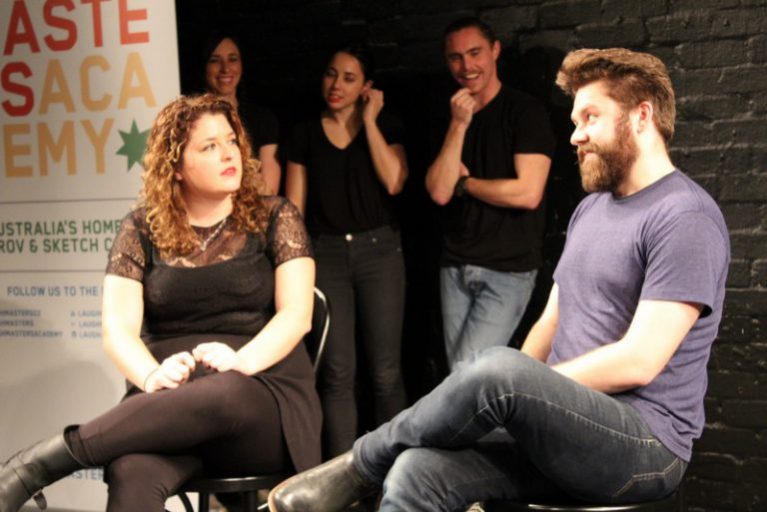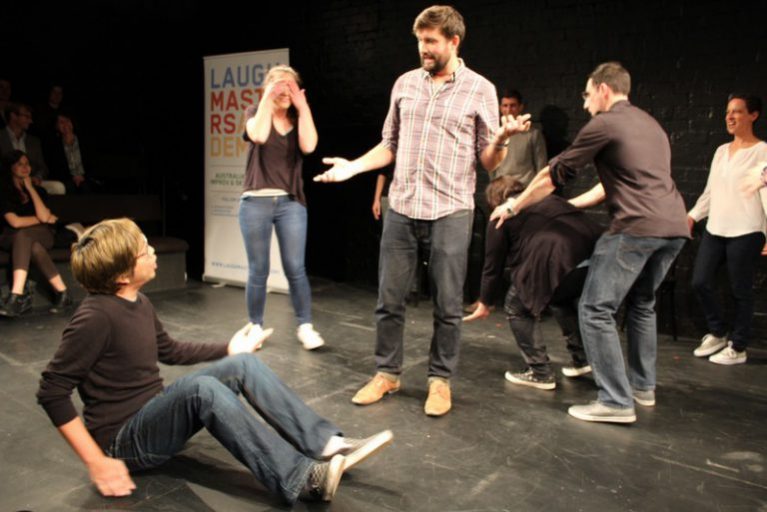The Game Tree: Tree of Game
- August 22, 2018
- Posted by: Josh Magee
- Category: Guest Blog , Improv.Blog , Instructors ,

Remember when you were a kid and your parents or your teacher said it’s “time to play a game?” Remember how exciting that was? Even if the game ended up being some bullshit like putting away your Lego – just the idea of a game used to be so fun and inviting that we would jump at the chance.
In our adult lives, the word “game” can feel so charged with implications that it loses its sheen. Is it going to be hard? Am I going to feel silly? Will I get addicted? Do I really have time to be playing a game right now with everything on my to-do list? Is this secretly my Dad still trying to trick me into putting away my goddamn Lego? I TOLD YOU, DAD, I’M GONNA PLAY WITH IT LATER. We’ve become wary of the game.
It’s the reason a lot of people take up improv. It’s a time set aside to “play,” free from the pressures of work or home or other social groups. The teacher explains an exercise and the players participate in that exercise. There’s no winner or loser – we operate on the understanding that it’s just fun to play whatever game we’re playing.
But then at a certain point in improv classes (at least in long form improv) you’re asked to create your own game. In the scene, in the moment, without talking about it, just by picking up on what you think your scene partner wants you to do. Deciding the rules as the game is being played. This can be a pretty terrifying prospect and often paralyzes people. “So, like… we can just do anything?” I imagine it’s what being released from prison feels like. It should be a joyous freedom, but the sheer amount of possibilities suddenly open to us can be crippling.
You know who doesn’t have a problem with this? Kids. (Making up games I mean, not adjusting to post-incarceration life, although they’d probably be good at that too) Especially toddlers, who only know a handful of games and yet use this to their advantage. The world is a much smaller place to children, they haven’t encountered most of the games there are to play, so they just work off what they know. Building blocks, peek-a-boo, foot race, pretend to be animals, kill the bad guy.
A kid who only knows these 5 games can very confidently make up a game in playtime, and what’s more, they can pick up on what game you’re trying to play with them. They know where all the moving parts from these games fit and what their purpose is. They also know when they’re having the most fun and allow this to be their guiding principle.
In improv, the “game” of any scene almost always bears some resemblance to one of a handful of core games you can play. I believe it’s important to understand these core game so that their moving parts can more easily be identified on the fly while in a scene. Some core games I like to teach, for example, are:
• A scene with an absurd person and a reasonable person,
• A scene with a reasonable person in an absurd world,
• A scene with two absurd people,
• A scene in which one familiar reality is mapped onto another.
This is certainly isn’t the only 4 core games that get played in improv scenes, but I find it’s usually a good place to start and encompasses most scenes. It’s important to note that there’s always some kind of absurdity present in these games. You could argue that the kid’s games I described above also each have an absurdity or at least an element that’s a departure from real life. Humans pretending to be animals for instance, or treating plastic blocks like they’re construction materials. (IT’S NOT THAT WEIRD, DAD. SO MANY ADULTS PLAY WITH LEGO)
Obviously, improv has to be somewhat more sophisticated than children’s games to be appealing to an audience though, so these games and their absurdities have to be sustained and deepened in order to be satisfying to watch for more than a few seconds. If inventing a game on the spot doesn’t feel daunting to an improv student, the task of keeping it alive often will. It doesn’t need to be as difficult as it sounds though. When kids are playing, they’re not thinking about how to cleverly morph pretending to be cats into pretending to be cheetahs into a footrace to the back fence – it just happens. What they do know is how to not kill the game. They let it grow where it wishes to and make sure there’s nothing in its way.
In this sense, I find it helpful to think of the game like a plant or a tree. When you’re growing a tree, you don’t have to actively push it up out of the ground, you just intermittently ensure it has the right conditions to grow and enjoy its presence the rest of the time. It does the growing on its own, you just have to know a bit of basic gardening to not kill it. Just like a tree’s ability to grow, your ability to play is natural.
Don’t let your adult-self get in the way of your inner child’s instinct to play. What is important is nurturing the thing on which the play is dependent. You can learn how to tend to a game to keep it fruitful. You need to make sure it has sunlight and fertile soil, make sure its roots have moisture and room to spread. Maybe you need to prune its branches now & again. Keep it clear of other games that are going to compete for its nutrients. It shouldn’t dominate your attention, but if you do it now & then, in between climbing its trunk and swinging on its tire, you’ll have it to play in for a lot longer.
What are the “branches” of an improv game? What are its roots? It’s trunk? Is this weird obsession with gardening actually a mid-life crisis I’m having?
Come and find out at my workshop “The Game Tree: Tree of Game” on September 29th!
Author: Josh Magee
Leave a Reply Cancel reply
You must be logged in to post a comment.







